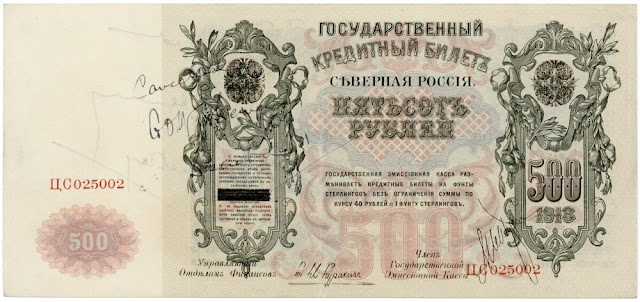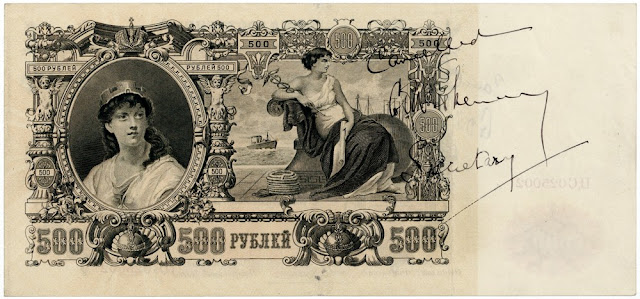North Russia 500 Rubles banknote 1918
North Russia State Credit Note
The images and colour were reminiscent of Russian Empire banknotes, but the notes were printed on thicker and rougher paper. In addition, the inscription "Northern Russia" appeared at the top of all banknotes. The money was backed with Russian gold and foreign currency in the Bank of England.
Obverse: On the obverse is the text: «ГОСУДАРСТВЕННЫЙ КРЕДИТНЫЙ БИЛЕТЪ. ПЯТЬСОТЪ РУБЛЕЙ». (STATE CREDIT NOTE. FIVE HUNDRED RUBLES) and the text: «Государственная Эмиссіонная Касса размѣниваетъ кредитные билеты на фунты стерлинговъ безъ ограниченія суммы по курсу 40 рублей = 1 фунту стерлинговъ.». (The State Emission Savings Bank exchanges state credit notes for Pound Sterlings without restrictions as to the total value at an exchange rate of 40 roubles = 1 Pound Sterling). On the lower left side depicted Guilloche rosette with the face value "500".
Signatures of the Governor of State Bank - Prince (Knyaz) Ivan Anatolievich Kurakin (During civil war he was Minister of finance in the Northern Region government in Arkhangelsk) and one of the members of the Board of Governors of the State Emission Savings Bank - Sir Emmanuel Musgrave Harvey.
The Imperial Crown of Russia above the Imperial Monogram of Tsar Nicholas II of Russia with crossed laurel branches above the relief panel with the face value in large arabic numeral "500" and the date of issue "1918" at right. The Imperial Coat of Arms of the Russian Empire, 1883 - Imperial Double-Headed Eagle above the relief panel with Russian (cyrillic) text at left.
Text:
1. Размѣнъ государственныхъ кредитныхъ билетовъ на фунты стерлингов обезпечивается всѣмъ достояніемъ Государства и особымъ неотчуждаемымъ заграничнымъ запасомъ, находящимся въ Aнглійскомъ банкѣ.
2. Государственные кредитные билеты имѣютъ хожденіе наравнѣ съ золотою монетою.
3. За поддѣлку кредитныхъ билетовъ виновные подвергаются лишенію всѣхъ правъ состоянія и ссылкѣ въ каторжную работу.
1. The exchange of State Credit Notes for Pound Sterling is ensured by the the whole property of the State and by a special inalienable foreign reserve, deposited at the Bank of England.
2. State Credit Notes circulate on par with gold coin.
3. Punishment for Forgery of the State Credit Notes the person who's guilty will be deprived of all property rights and is sent to hard labour.
(black overprint on Imperial Crown and on Imperial Monogram of Tsar Nicholas II of Russia)
Reverse: Allegorical Portrait of a Lady. At the top of the portrait depicted the Imperial Crown of Russia and Imperial Orb in the seashell like pearl at the bottom. At center: Allegory of the Freedom of Trade - seated young allegorical woman with globe and caduceus and ships in background. Design of the banknote consist the various architectural elements of Rococo style.
Printer: Waterlow & Sons Limited, London England.
Size: 260 х 122 mm.
Watermark: lines.
North Russia banknotes 1918 - 1919
5 Rubles 10 Rubles 25 Rubles 100 Rubles 500 Rubles
North Russia - Northern Oblast
Northern Oblast (Russian: Се́верная о́бласть) was a territory in the northwest of Russia controlled by the White movement during the Russian Civil War. Its administrative center was Arkhangelsk.
The oblast was established on August 2, 1918 after the Soviet power fell in Arkhangelsk Governorate. On August 6, 1918, the Murmansk Krai Soviet authorized Chairman Yuryev to agree on the inclusion of Murmansk Krai into Northern Oblast. On September 15, 1918, the Provisional Government issued a resolution which accepted Murmansk Krai as a part of Northern Oblast. In October 1918, all the soviets were abolished and zemstvos were restored.
The new leftist regime called the Supreme Administration of the Northern Region was led by the veteran Populist Nikolai Tchaikovsky. It was toppled by the military on September 6, 1918, and Tchaikovsky was incarcerated in the monastery on Solovetsky Islands. Later, on September 28, 1918, Tchaikovsky was freed and permitted to establish a new government, the Provisional Government of the Northern Region. In January 1919, Tchaikovsky was replaced by General Yevgeny Miller.
A Northern Army was formed in the Northern Oblast under command of Vladimir Marushevsky to fight the Bolsheviks.
After the Allies withdrew, the Whites quickly collapsed and the oblast ceased to exist. The remnants of the army were evacuated from Arkhangelsk in February 1920. General Yevgeny Miller escaped from Arkhangelsk to Norway.

